With 1989, Taylor Swift finally grows up

Much has been made about Taylor Swift’s gradual transition from country songbird to pop star, and make no mistake, 1989 is a straight-up pop record. But even on her earliest and most countrified tracks, like 2006’s “Tim McGraw,” Swift still seemed more like a pop star than a tractor-drivin’, boot-wearin’ backwoods babe. Take away the mandolin twang on “McGraw,” kick up the beat, and switch up the references, and the song could have been a hit across the dial. Ditto Swift’s other big singles, like “Love Story,” “Fearless,” and “Our Song.”
So it should come as no surprise that eight years into her career, Taylor Swift has decided to go pop. Each of Swift’s four previous records have been progressively less interested in keeping up with the Nashville sound, and given that Swift’s new hometown is New York, not Nashville—as made perfectly evident in 1989’s opening “Welcome To New York,”—she’s gone full big-city strut with the help of iconic pop producers like Max Martin.
1989 succeeds not just because of those producers, but because Swift is, if nothing else, a bit of a perfectionist. You can see it in her perfectly put together outfits and her love for Martha Stewart, and you can hear it in the way she puts together a couplet. Even Swift’s references for this record—reportedly Annie Lennox, Madonna, and Fine Young Cannibals—are perfect. That she twists those influences to come up with songs that sound more like something Haim, Lorde, or Lana Del Rey might have already put out—that was inevitable. Swift’s never really been one for breaking any big sonic barriers.
That’s not to say that 1989 isn’t good, because it is. Lead single “Shake It Off” is undeniable, and while “Welcome To New York” basically sounds like it was written for a commercial (and, hey, it kind of was, considering how Swift’s become New York’s new cultural ambassador), it’s still catchy. “Blank Space” calls up some Lorde beats and pairs them with some relatively dark lyrics for Swift, with lines about how she “can make the bad guys good for a weekend,” and how she’s looking for her “next mistake.” Swift’s always sung about her romantic ups and downs, but on 1989, she’s adopted a slightly more adult attitude: She’s not necessarily looking for her Mr. Forever anymore. She’s just looking for someone she can have some fun with now, seemingly fine with the fact that any relationship is either “gonna be forever” or “go down in flames.”
Other tracks, like the Jack Antonoff-produced “Out Of The Woods” and “I Wish You Would” call up some major Haim vibes, sounding like they were ripped (as an old co-worker put it), straight from the soundtrack of Mannequin 2. “Out Of The Woods” in particular is full of echoed “oh-ohs” and dimensional sound, something that Swift really uses to her advantage. And on “Wildest Dreams,” Swift even takes her voice down a few notches, sounding a bit more like the brusque Del Rey than her chipper self.
There are some iffy songs on 1989. Swift’s commitment to always putting 13 tracks on a record (it’s her lucky number!) means a few mediocre midtempo ballads made the cut. “How You Get The Girl,” “This Love” and “I Know Places” in particular are just okay, but they’re buried deep on the record, far past most of the singles. They’re also not bad songs, necessarily—they’re just reminiscent of Swift’s older material, and, compared to the rest of 1989, they seem out of place.
It’s almost refreshing that, after eight years of success in the recording industry, Swift decided now was the time to go pop. Swift always seemed like such an old soul, a 16-year-old worried about when she was going to meet her Romeo. And while that sells, it’s a pretty unrealistic outlook on life. 1989 suggests that, even though she’s making silly videos about how awkward it looks when she twerks, Swift has matured. And thank God, because that cloying optimistic romanticism was getting a little annoying. Swift’s never going to be as bleak as Del Rey or as sexually frank as Madonna, but, on 1989, she’s figured out how to be an adult once and for all.